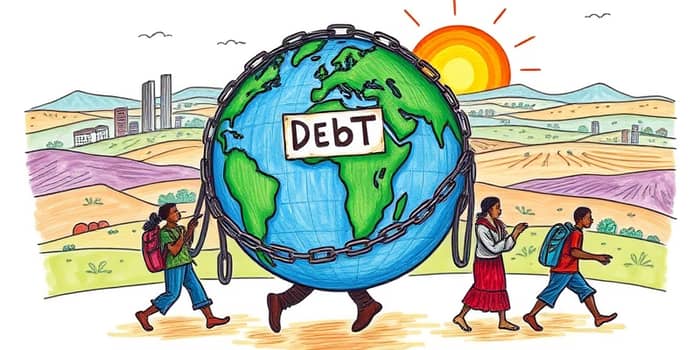
Developing nations around the world are confronting an unprecedented surge in sovereign debt. As interest payments spiral, governments find themselves at a crossroads: either default or sacrifice essential public services. This article examines the evolving crisis, its human impact, and the path toward sustainable solutions.
In 2024, net interest payments on public debt in developing economies soared to $921 billion, a 10% increase from the previous year. More than half of these nations now allocate over 10% of their total revenues solely to interest payments, with 24 low- and middle-income countries surpassing the 20% mark.
Such figures illustrate the soaring public debt burdens choking national budgets. The IMF warns that, under adverse conditions, global public debt could reach 117% of GDP by 2027, a looming threat that demands attention.
Behind each statistic lies a population facing real hardship. An estimated 3.3 billion people live in countries where debt servicing exceeds expenditures on health or education. In Kenya, interest payments have approached 60% of government revenue, sparking mass protests and social unrest.
Citizens in climate-vulnerable states—23 of the 50 most at-risk nations—are particularly hard hit, with essential services stretched beyond breaking points. The resulting distrust in public institutions can undermine democratic stability and long-term development prospects.
These elements reinforce one another, creating a cycle that is difficult to break. For instance, Ghana’s cedi depreciation caused debt servicing costs to rise even as its principal obligations shrank.
This table highlights how different nations face unique triggers—economic shifts or natural disasters—that push them toward debt distress.
International bodies and local governments are exploring various mechanisms to alleviate the squeeze. One notable idea is the use of pause clauses, which allow temporary suspension of payments during crises, as demonstrated by Grenada after a hurricane.
Experts also call for the expansion of innovative financing mechanisms and solutions, including:
Yet, progress remains hampered by limited political will and fragmented international cooperation—an unfortunate reality when urgent action is needed most.
To break free from the debt trap, policymakers must pursue a multi-pronged approach. First, credible medium-term fiscal frameworks can restore investor confidence and stabilize borrowing costs. Second, strengthening domestic revenue mobilization reduces reliance on volatile external financing.
Finally, there is a collective responsibility to bolster urgent international cooperation and relief. Without substantial debt relief or restructuring, many countries will be forced to choose between default and drastic service cuts.
The rising tide of sovereign debt in developing economies represents both an economic challenge and a moral imperative. Governments, multilateral institutions, and private creditors must collaborate on fair and transparent restructuring processes that prioritize human well-being.
By embracing comprehensive debt relief, promoting equitable financing terms, and supporting capacity building, the global community can help ensure that developing nations reclaim their fiscal health without sacrificing growth or social progress.
Ultimately, the crisis of sovereign debt is more than a balance-sheet problem—it is a test of our shared commitment to fairness, solidarity, and sustainable development. The time to act is now.
References













